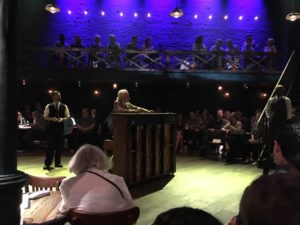Operatic
Posted: Mon 4 December, 2017 Filed under: Domestic, London, Reviews(ish), Single Life, Theatre, Theatre, Thoughts Leave a comment »On Saturday, I went to my first opera – a production of Aida at the London Coliseum by English National Opera. As with going to plays and so on, I went in with very little knowledge of Aida or what to expect.
I did enjoy it – although it’s not necessarily something I’d plan to go to on a regular basis, or to see this particular opera again. I don’t yet know – but as with other things, I’m not going to base any judgements or expectations on a sample of one, so I’ll definitely be going to at least one more production.
*Personally*, I found that the first half dragged, but the second half was better. The staging throughout was really interesting though, which did help things.
The plot/story is hideously melodramatic (in my opinion) and would’ve been rejected from most soap operas as being too ridiculous. So yeah, the odds are I won’t bother with Aida again, but there’s plenty of others I can try instead.
All good fun, though…
The Man Behind The Curtain
Posted: Wed 11 October, 2017 Filed under: Day Trips, Domestic, Driving, Food, M1, Reviews(ish), Travel Leave a comment »I mentioned in the last post that I’d done a day-trip to Leeds, and that I would write more about it. So, here we are.
One of the Michelin-starred restaurants I’ve been wanting to try for a while is Michael O’Hare‘s “The Man Behind The Curtain” in Leeds. It’s always been booked solid, but when I looked on a whim a couple of months ago, I discovered that there was a table for four free for a late lunch on Saturday. I called the other friend who was interested in the same place , and I booked it.
That’s where the first shock came in. The entire price of the meal was paid at the time of booking, including the wine – and the service charge! Now to me, that’s taking the piss. The only other Michelin-starred place I’ve seen with that attitude is The Fat Duck, and even there it’s “only” the food that is paid for ahead of time, not the wine and tip. Every other place I’ve been has taken a credit card number, and said “if you don’t show up, you’ll pay the full price”, which is fine with me. Paying up front for it all seems very dodgy.
Anyway, I did that, and last Saturday was the day.
I’d hired a car for doing it as a day-trip, as I was also driving the others there and back, and it makes life fun.
“The Man Behind The Curtain” is… highly individual. First things first, it’s on the top floor of a department store – definitely not somewhere you’d just wander into! As it turns out, it now *was* on the top floor – our meal was the last lunch served in the top floor, and they were moving to the basement after the dinner service.
It’s a strange space, seemingly more of a gallery than a restaurant. The walls were graffitied and arty, with chicken-wire clouds above some tables. I’ve never been anywhere else like it – but that also shows in the food. Again it’s very arty – some of the food is quite spectacular, as is the crockery it arrives in. In particular, “Emancipation”, which is cod in squid-ink, basically black food on a black “droplet” plate…
That was just one of the ten ‘courses’. And they were all brilliant.
Honestly, I kind of wanted to not like it, to be unimpressed by the entire place. I feel really strongly about the whole ‘pay upfront’ thing, and think it gives a really bad impression of the restaurant. But the food, the atmosphere, and the service of the place all combined to leave me still impressed.
It was a really good day, and decent drives there and back (two hours door-to-door each way) helped as well.
Saturday – Chris Ofili, Weaving Magic
Posted: Fri 11 August, 2017 Filed under: Art, Day Trips, Domestic, London, Reviews(ish), Thoughts, Travel Leave a comment »Following on from seeing the Giacometti and Soul of A Nation exhibitions, my final visit was to the National Gallery, to see “Weaving Magic” by Chris Ofili.
A friend of mine had seen this and really liked it, hence why I wanted to see it.
It’s a fantastic tapestry – designed by Ofili, and then handwoven by Dovecot Tapestry Studio, and based on “I know why the caged bird sings“, by Maya Angelou. It’s also been staged and displayed really well, in a room of its own, which has also been decorated by Ofili.
So you end up with a room covered in murals like this
And then the tapestry itself, the only thing of colour in the room
It’s well worth seeing – if you get the chance to go before the end of August, I’d recommend it. Even better, it’s free to go in and see it, which is… noteworthy, in the current climate.
Detroit
Posted: Wed 9 August, 2017 Filed under: Domestic, Films, Reviews(ish), Seeing Films, Thoughts Leave a comment »In a weirdly – and unintentionally – connected thing to seeing the Soul Of A Nation exhibition over the weekend, I also ended up seeing “Detroit” last night.
“Detroit” is a new film from Katheryn Bigelow (the director of the original Point Break, Hurt Locker, Zero Dark Thirty, and many others) about the Detroit (unsurprisingly) 12th Street race riot, and in particular the Algiers Motel incident.
That incident is (yet another) one I didn’t really know anything about until seeing the film. I don’t believe it’s one that has gone into ‘common knowledge’ – while I’m no expert on these things, it’s not one I’ve ever heard even mentioned, and I don’t honestly think it’s even left a large imprint on American history.
Anyway, the film is an interesting one – but (in my opinion) tries too hard, telling too many stories in one film. There could have been a film about the riots themselves, the causes, the people, the effects. There could have been a film about just the Algiers incident – although I suspect that the conclusion of that would’ve been deeply unsatisfactory. And there could’ve been one about the aftermath, the court case(s), the people, and what happened to them afterwards.
But trying to do all of those within the scope of one film – admittedly, a bloody long film at 14o-odd minutes – is difficult, at best. It starts with the riots, and we don’t even really meet any of the “main” characters for a good half an hour. Then we go to the Algiers, which is as bad as it could be – and probably pretty truthful, as one of the people involved was on set every day, advising and providing input. And then for the final half hour or so, we’re in the court case, the details, the results, and the aftermath.
If the film had been longer, it might’ve gelled better, become a whole story. As it is, it feels overly-edited, almost like a ‘greatest hits’ rather than a full story. It’s still a good film, and a story that should be told. It’s just that the story deserves to be properly told, not in a hodge-podge of setpieces.
Saturday – Giacometti
Posted: Mon 7 August, 2017 Filed under: Art, Creativity, Day Trips, Domestic, London, Reviews(ish), Thoughts, Travel Leave a comment »On Saturday, I went into London for a walk, and to visit a couple of exhibitions – which turned out to be three – as well as food and the like. As there’s other stuff going on this week that I can’t be naffed to go into right now, I thought I’d write a bit about some thoughts related to the exhibitions. So that’s the plan.
The first one on the list was Tate Modern’s exhibition of works by Giacometti. Up ’til now, I’ve seen a few of his works, but not loads – and I’ve honestly never seen the appeal of them. They’re certainly distinctive, strange, and of note – but I certainly didn’t love them, and didn’t really get why he’s so well regarded.
Having seen the full exhibition, I still don’t love them, but I understand more of why he’s regarded. Oddly, his statues still do very little for me – I find them kind of odd, and kind of unsettling, but nothing more than that – and I certainly couldn’t sit and just look at one block of statues, as one person was doing. (He’d even brought along his own camping stool in order to do so, God love him) However, I really liked some of the sketches, and some of his oil work that looked like it had been done in charcoal.
I think that in some ways I wasn’t convinced of Giacometti as being an actual artist – OK, he could do the sculptures, but that could’ve been just the one thing. Having seen the sketches, drawings, and paintings, I do realise that he’s a lot more of an artist than I’d thought, and a lot more talented.
That doesn’t make me like the sculptures and so on, and I still wouldn’t go from here to the bog to see another exhibition of his work, but all the same, I’m glad I did go.
The Resistible Rise of Arturo Ui
Posted: Fri 16 June, 2017 Filed under: Day Trips, Domestic, London, Reviews(ish), Theatre, Theatre, Thoughts, Travel Leave a comment »Following on from a friend of mine seeing it, I decided to have a look and see if there were any tickets still available for “The Resistible Rise of Arturo UI” at the Donmar Warehouse on the date I was available in London with no solid plans. (Last Saturday) As it turned out, there was – just one ticket apparently “near the back”. That’s OK, I’m tall, so yep, ticket successfully obtained.
As usual with my theatre trips, I knew absolutely sod-all about the play. Indeed, I’d never even heard of it before the previous weekend. That doesn’t bother me anyway, and armed with a decent review from someone whose opinion I tend to trust, I was willing to go for it. All I knew was the name, and that it was by Bertolt Brecht.
And I’m really glad I did. The original play is an allegory based around the rise of Hitler in Germany, but using the gangsters of 1920s/1930s America to tell the story. It’s been updated a bit – there were lots of references to Trump and his collaborators, along with an (odd but effective) sung intro to each major scene, using modern(ish) songs.
It’s very hard to not see the parallels between Nazi Germany and Trump’s rise, so it all felt very relevant. But still interesting in a lot of ways.
The entire of the Donmar Warehouse has been changed for this production, and it’s been made into a 20s/30s speakeasy. As you walk in, the actors are already on ‘stage’ talking, dancing and the like. It certainly made things more interesting, having Lenny Henry come round in character as the club owner, talking to – and shaking the hands of – all the guests, as well as other cast members doing the rounds.
As an aside, one thing that was great was that a lot of the audience around me were a group of visually-impaired people, coming to the theatre for a play that would also be audio-described for them by a company called TalkingSense – and as it turned out, I got talking to one of the narrators, who was sat next to me for the first half, before going to narrate the second half. I thought it was brilliant to open up theatre in this way (and I also liked that Arturo Ui managed to use one of the visually-impaired people as his ‘witness’ for one section)
Ah yes, the audience participation. This was something really interesting, and not something I’d expected at all – this version of the play makes great use of the audience. In the photo above you can see a gallery with people on it – in the second half, these become the jury for a court case, with the judge sat in the middle. Another audience member became the railroaded ‘accused’, and by the end of the play everyone is involved, either standing in support of Ui’s bid to be the main gangster (sorry, “protector”) or sitting – in which case their votes don’t count.
Note – I’m not giving away anything major here – and the production ends tomorrow!
Lenny Henry is particularly impressive as the titular gangster, developing through the production. But he’s also well supported by a generally excellent cast – all of whom also seem to be enjoying taking part in the play. (Which isn’t always the case)
All told, it’s a very dark vision of life – yet also extremely funny. I laughed a lot more than I would have ever expected to, in a play based on the rise of Nazi-ism. If the run were longer, I’d probably enjoy going to see it again. It’s quite a thing.
King Arthur, Legend of the Sword
Posted: Fri 19 May, 2017 Filed under: Domestic, Films, Reviews(ish), Seeing Films, Single Life Leave a comment »Last night, I went to see the new Guy Ritchie film, “King Arthur – Legend of the Sword“. It is, to be charitable, a bit of a mess.
I wasn’t expecting high-art, or a high-brow version of the Arthurian Legends – it’s a Guy Ritchie film, so anyone expecting that would be sorely disappointed anyway. But I was expecting a Guy Ritchie film – a significant portion of silliness, snappy and smart dialogue, and some impressive visuals/shots. This is the man who brought us “Lock, Stock and Two Smoking Barrels”, “Snatch”, “Sherlock Holmes” (and its sequel) and “The Man From Uncle” – all of which qualify on all those things, and all of which I like.
But this one… well.
It’s got silliness – but in this case it veers more towards the ridiculous. Yes, ridiculous even within the pantheon of Arthurian stuff. The mage-driven war-elephants larger than mountains were a particular “high” point in this. But at least they were visually impressive. Which leads me to…
Visuals – it’s got some gloriously shot scenes and set-pieces. But the rest is a mess. Even some of those setpieces, there’s just too much going on for it to make sense. It needs to convey the speed and fury and chaos of battle – and in some ways I guess it does that, as no-one has any fucking clue what’s going on. But it’s also a film, and you should be able to at least see what’s happening. There are bits that are visually brilliant, but then the rest just detracts from those pieces.
Dialogue – it’s got it. But again, like the silliness, it feels forced, and it doesn’t fit with the characters, or the time. There are a couple of larger pieces that are definitely meant to be “Lock, Stock and Broadsword”, but they simply don’t work, even with snappy camerawork to accompany them.
Some of it may also be down to the cast – I like Charlie Hunnam in most things, but he does come across as being more of a supporter than a star. So having him as the main character doesn’t necessarily help things – but it does seem far more like the script is a complete dog-egg, and they’ve all just done what they can with it. And if that’s the case, then it’s really Guy Ritchie who’s primarily responsible, as he’s the writer of the original screenplay too.
All told, the nicest I can say is that it’s a mess. Not one I’d go and see again, it’s fair to say.





